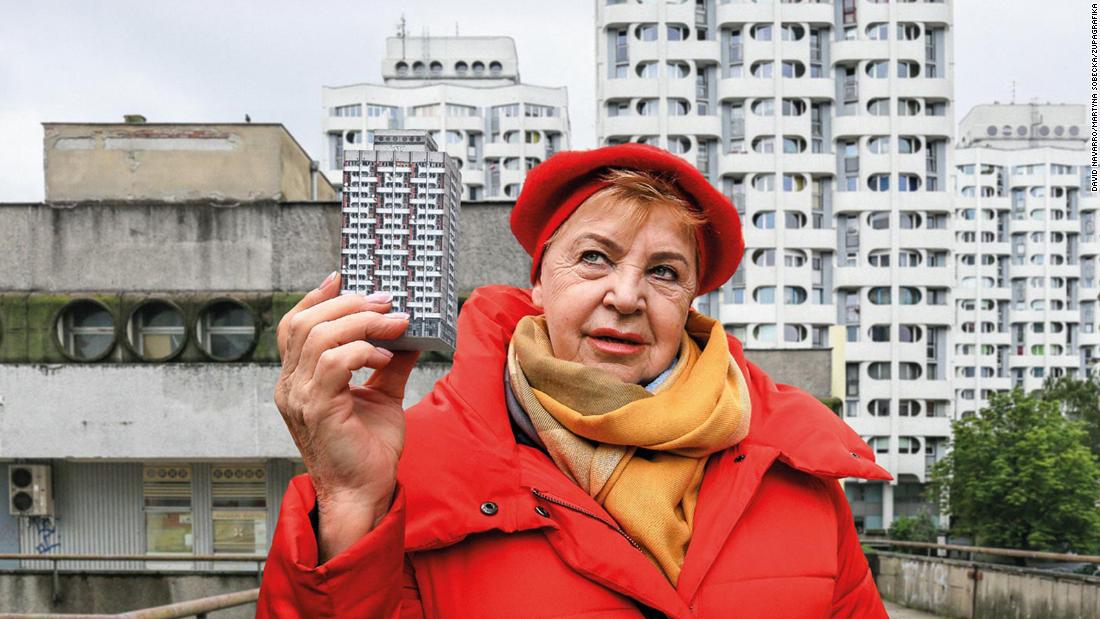
Across the former Soviet Union and Eastern Bloc, huge concrete complexes stand as testament to Europe’s post-war housing drive. Constructed en masse in the second half of the 20th century, their utilitarian designs were usually geared toward providing homes as quickly and cheaply as possible.
But while some of these developments have since been razed or fallen into disrepair, many have outlived the communist governments that built them.
In 2012, David Navarro and Martyna Sobecka, founders of the publishing house and design studio Zupagrafika, began documenting Eastern Europe’s aging concrete blocks — and meeting the people who still call them home. Initially, the pair intended to photograph paper architectural models against the buildings they represented, though they instead asked residents to pose for portraits holding the illustrations.
A decade later, and with the help of photographers from across the region, they have published images and stories from 40 housing projects in 37 different cities.
From what was once East Berlin to the remote Russian city of Norilsk, Navarro and Sobecka found that occupants of these often-reviled buildings complain of issues including poor insulation and lack of maintenance. But they also discovered many residents who were complimentary and nostalgic about their Cold War-era homes.
Barbara, Plac Grunwaldzki housing estate in Wrocław, Poland (pictured top)
“I was one of the first tenants here. I absolutely love my apartment on the fourth floor. I have three spacious rooms with a small kitchen.
“The only disadvantage is the pigeons, oh dear, that’s really terrible! The renovation looks pretty and clean on the outside but they didn’t lay ceramics on the balcony floors, as they promised. Besides, the tenants are still paying about 200 zloty ($43) a month each for this renovation.”
Josef, Jižní Město housing estate in Prague, Czech Republic

David Navarro/Martyna Sobecka/Zupagrafika
“These panelák (pre-fabricated concrete) houses were built very quickly so that people had places to live. Everybody liked it here. Then the Velvet Revolution came and they wanted to tear them down; if they had demolished them, we would not have homes today.
“When we were buying an apartment here it was very affordable, now they are available for 4 million koruna ($166,000), quite expensive for people who don’t have much money.”
Zinaida, Novosmolenskaya housing complex in Saint Petersburg, Russia

Alexander Veryovkin/Zupagrafika
“There are almost no young people living here, but the house has a lot of advantages: It is relatively quiet, close to the metro and there is plenty of greenery around. The main disadvantage is that the walls, floors and ceilings are uneven. Probably something went wrong during construction.”
Givi, Sky-Bridge housing estate in Tbilisi, Georgia

Giorgi Zatiashvili/Zupagrafika
“I have lived on the bridge floor for 40 years. Before the bridges were constructed, the entire floor was closed down and I was the only one staying there.
“These rounded windows used to be balconies which couldn’t be transformed back then. Now, some of the tenants have covered them up to have more heated room inside, only their exhaust fumes rise up to my balcony.”
Divna, Eastern City Gate of Belgrade in Belgrade, Serbia

Milos Stankovic/Zupagrafika
“The buildings are old and well-constructed. They are the statues of Belgrade. Their foundations are deeply grounded protecting even higher floors from earthquakes.”
Christin, Berliner Querplatte in Berlin, Germany

David Navarro/Martyna Sobecka/Zupagrafika
“I was born in (the eastern district of) Prenzlauer Berg and moved here in the 1970s. I live on the ninth floor and I have a two-bedroom apartment, more than enough room for me and my dog.
“The rent is 500 euros ($511) a month and for my modest pension it is quite a lot, but it isn’t much for this great location, is it? I can see the Television Tower from my window!”

Zupagrafika

